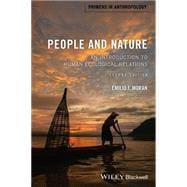Now updated and expanded, People and Nature is a lively, accessible introduction to environmental anthropology that focuses on the interactions between people, culture, and nature around the world.
- Written by a respected scholar in environmental anthropology with a multi-disciplinary focus that also draws from geography, ecology, and environmental studies
- Addresses new issues of importance, including climate change, population change, the rise of the slow food and farm-to-table movements, and consumer-driven shifts in sustainability
- Explains key theoretical issues in the field, as well as the most important research, at a level appropriate for readers coming to the topic for the first time
- Discusses the challenges in ensuring a livable future for generations to come and explores solutions for correcting the damage already done to the environment
- Offers a powerful, hopeful future vision for improved relations between humans and nature that embraces the idea of community needs rather than consumption wants, and the importance of building trust as a foundation for a sustainable future








